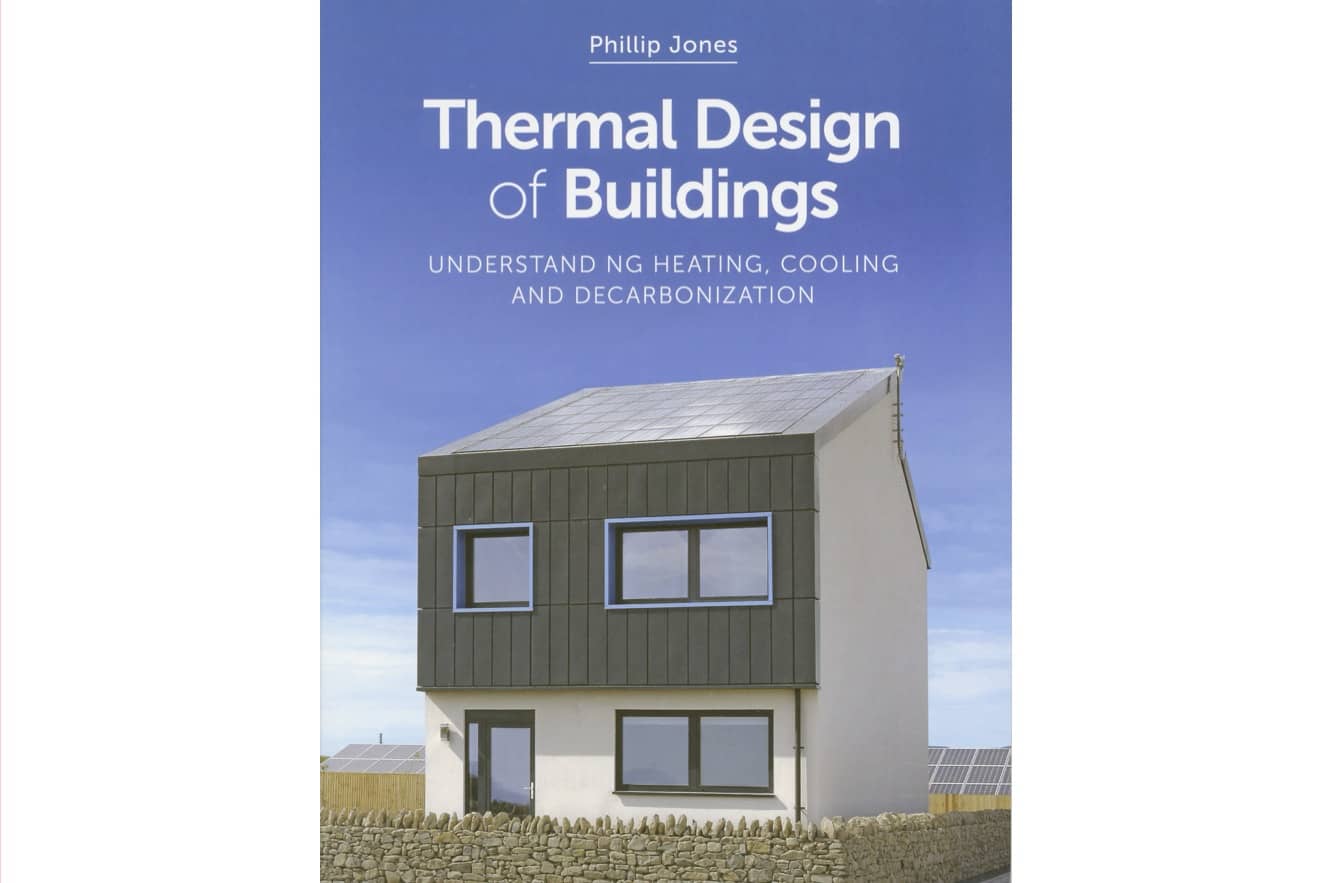
www.buildingsandcities.org/insights/reviews/thermal-design-buildings.html
Thermal Design of Buildings: Understanding Heating, Cooling and Decarbonization

by Phillip Jones. Crowood Press, 2021, ISBN: 9781785008986
Jenny Crawley (UCL) reviews this book which provides a sound basis for understanding and creating low energy design solutions that are grounded in the underlying principles of thermal design.
Thermal Design of Buildings is a helpful book which explains and applies physical principles in order to help the reader understand the relationship between buildings and energy. It is broadly structured by presenting the context of climate change and net zero buildings, then the different aspects of thermal design (building fabric, ventilation, building services), followed by a chapter illustrating the application of these aspects over the last 50 years, and ending with a reflection on ways forward.
The author aims to 'provide an insight into current thinking in thermal design, with reference to its historical context, as well as signposting future developments'. Since solutions evolve, the aim is 'not to provide off the shelf recipes but to provide an understanding of the subject of thermal design, and an awareness of what is possible, from which future innovative solutions can be developed'.
The book meets these aims and fulfils its aspirations admirably. The 'awareness of what is possible' is an important inclusion, in order to ground aspirations in real physics. For example, the book illustrates the variable amount of solar radiation in different countries. This shows how difficult it would be to provide all of a building's energy from its own solar panels some countries, but more feasible in others. In addition, the reader is shown how to calculate important metrics (including certain key equations such as ventilation airflow through openings, and U-values of constructions), without being a dry book full of equations.
The book makes its points strongly and with the right level of detail. For example, there is a very valuable section illustrating that different building types have different heating/cooling and ventilation requirements, enhancing the point that each building needs a different solution depending on what is going on both inside and outside. Just occasionally there is too much detail in my opinion. For example, a table of different types of chiller compressors, which may not be in the reader's remit to specify.
Some key themes that emerge are:
- Thermal design is not one-size-fits-all, but is specific to the location of the building (and always has been through history) as well as what happens on the inside of the building
- An understanding of thermal design principles is essential for designers. The book provides a sound approach to the underlying physics - as opposed to simply presenting a list of technologies (e.g. compression chiller, absorption chiller, etc)
- Presenting typical numbers is very helpful for the reader to understand the simple potential of different options, and then dynamic building simulations can help the reader see for themselves how the different solutions might work.
These are really valuable points that the book conveys clearly. In particular, Jones successfully argues that by understanding the physical principles of the different design elements one can start to combine them in the most appropriate ways (for example, understanding how a thermally efficient building fabric can allow a low temperature heat distribution system).
The incorporation of a historical perspective on thermal design is perhaps quite novel. As well as the excellent section on vernacular architecture around the world, there is a chapter on the history of low carbon building from the 1970s and what we have learned or not learned. It also brings in the subject of fuel cost, which helps to explain why we may or may not have seen adoption of thermal design principles up to now.
The intended audience is 'those interested in sustainability and the built environment, including students, practitioners, policy makers and the public'. It definitely makes a good student text: it introduces just the right amount of physics (although a little more on thermodynamics would perhaps have been helpful) and applies it to different fabric and HVAC (heating, ventilation and air conditioning) strategies, including many helpful case studies. Some topics, like the psychrometric chart, are probably not understandable solely from the provided description but at least students are introduced to what it is and can go and read more about it elsewhere.
In addition, the book is well suited to practitioners too. It includes many useful rules of thumb and typical numbers (e.g. the typical temperature of water supplied to a chilled ceiling), then uses simulations to show more complex aspects (e.g. how much cooling a chilled ceiling can give over a day with varying outdoor temperature). This combination of helpful rules of thumb with simulations to illustrate the details is one of my favourite aspects of the book.
Some of the book is accessible is to policy makers and the public. The final chapter, entitled 'Transition', presents a reflection on wider changes that are needed in order to create an environment in which net zero buildings can get built. These include procurement, a discussion of top-down and bottom-up policy approaches, and some reflections on the way forward.
The focus of the book is design. However, a well evidenced and widespread problem in the real world is the performance gap, in which buildings are not built and / or operated in accordance with the intended design. This issue is mentioned a few times, but perhaps could have been treated in a little more depth, with examples of specific checks which can be undertaken at different stages in the design, build, commissioning and operational phases. Perhaps a further book by Philip Jones is needed to address this phenomenon.
Thermal Design of Buildings gives a holistic understanding of why and how net zero building design can and should be realised. The book is to be applauded for providing a useful, insightful and clear approach to thermal design and energy demand reduction. I certainly will be recommending it to my students as a useful resource.
Latest Peer-Reviewed Journal Content
A framework for 1.5°C-aligned GHG budgets in architecture
G Betti, I Spaar, D Bachmann, A Jerosch-Herold, E Kühner, R Yang, K Avhad & S Sinning
Net zero retrofit of the building stock [editorial]
D Godoy-Shimizu & P Steadman
Co-learning in living labs: nurturing civic agency and resilience
A Belfield
The importance of multi-roles and code-switching in living labs
H Noller & A Tarik
Researchers’ shifting roles in living labs for knowledge co-production
C-C Dobre & G Faldi
Increasing civic resilience in urban living labs: city authorities’ roles
E Alatalo, M Laine & M Kyrönviita
Co-curation as civic practice in community engagement
Z Li, M Sunikka-Blank, R Purohit & F Samuel
Preserving buildings: emission reductions from circular economy strategies in Austria
N Alaux, V Kulmer, J Vogel & A Passer
Urban living labs: relationality between institutions and local circularity
P Palo, M Adelfio, J Lundin & E Brandão
Living labs: epistemic modelling, temporariness and land value
J Clossick, T Khonsari & U Steven
Co-creating interventions to prevent mosquito-borne disease transmission in hospitals
O Sloan Wood, E Lupenza, D M Agnello, J B Knudsen, M Msellem, K L Schiøler & F Saleh
Circularity at the neighbourhood scale: co-creative living lab lessons
J Honsa, A Versele, T Van de Kerckhove & C Piccardo
Positive energy districts and energy communities: how living labs create value
E Malakhatka, O Shafqat, A Sandoff & L Thuvander
Built environment governance and professionalism: the end of laissez-faire (again)
S Foxell
Co-creating justice in housing energy transitions through energy living labs
D Ricci, C Leiwakabessy, S van Wieringen, P de Koning & T Konstantinou
HVAC characterisation of existing Canadian buildings for decarbonisation retrofit identification
J Adebisi & J J McArthur
Simulation and the building performance gap [editorial]
M Donn
Developing criteria for effective building-sector commitments in nationally determined contributions
P Graham, K McFarlane & M Taheri
Reimagining circularity: actions for optimising the use of existing buildings
R Lundgren, R Kyrö, S Toivonen & L Tähtinen
Effective interdisciplinary stakeholder engagement in net zero building design
S Vakeva-Baird, F Tahmasebi, JJ Williams & D Mumovic
Metrics for building component disassembly potential: a practical framework
H Järvelä, A Lehto, T Pirilä & M Kuittinen
The unfitness of dwellings: why spatial and conceptual boundaries matter
E Nisonen, D Milián Bernal & S Pelsmakers
Environmental variables and air quality: implications for planning and public health
H Itzhak-Ben-Shalom, T Saroglou, V Multanen, A Vanunu, A Karnieli, D Katoshevski, N Davidovitch & I A Meir
Exploring diverse drivers behind hybrid heating solutions
S Kilpeläinen, S Pelsmakers, R Castaño-Rosa & M-S Miettinen
Urban rooms and the expanded ecology of urban living labs
E Akbil & C Butterworth
Living with extreme heat: perceptions and experiences
L King & C Demski
A systemic decision-making model for energy retrofits
C Schünemann, M Dshemuchadse & S Scherbaum
Modelling site-specific outdoor temperature for buildings in urban environments
K Cebrat, J Narożny, M Baborska-Narożny & M Smektała
Understanding shading through home-use experience, measurement and modelling
M Baborska-Narożny, K Bandurski, & M Grudzińska
Building performance simulation for sensemaking in architectural pedagogy
M Bohm
Beyond the building: governance challenges in social housing retrofit
H Charles
Heat stress in social housing districts: tree cover–built form interaction
C Lopez-Ordoñez, E Garcia-Nevado, H Coch & M Morganti
An observational analysis of shade-related pedestrian activity
M Levenson, D Pearlmutter & O Aleksandrowicz
Learning to sail a building: a people-first approach to retrofit
B Bordass, R Pender, K Steele & A Graham
Market transformations: gas conversion as a blueprint for net zero retrofit
A Gillich
Resistance against zero-emission neighbourhood infrastructuring: key lessons from Norway
T Berker & R Woods
Megatrends and weak signals shaping future real estate
S Toivonen
A strategic niche management framework to scale deep energy retrofits
T H King & M Jemtrud
Generative AI: reconfiguring supervision and doctoral research
P Boyd & D Harding
Exploring interactions between shading and view using visual difference prediction
S Wasilewski & M Andersen
How urban green infrastructure contributes to carbon neutrality [briefing note]
R Hautamäki, L Kulmala, M Ariluoma & L Järvi
Implementing and operating net zero buildings in South Africa
R Terblanche, C May & J Steward
Quantifying inter-dwelling air exchanges during fan pressurisation tests
D Glew, F Thomas, D Miles-Shenton & J Parker
Western Asian and Northern African residential building stocks: archetype analysis
S Akin, A Eghbali, C Nwagwu & E Hertwich
Join Our Community

The most important part of any journal is our people – readers, authors, reviewers, editorial board members and editors. You are cordially invited to join our community by joining our mailing list. We send out occasional emails about the journal – calls for papers, special issues, events and more.
We will not share your email with third parties. Read more



Latest Commentaries
COP30 Report
Matti Kuittinen (Aalto University) reflects on his experience of attending the 2025 UN Conference of the Parties in Belém, Brazil. The roadmaps and commitments failed to deliver the objectives of the 2025 Paris Agreement. However, 2 countries - Japan and Senegal - announced they are creating roadmaps to decarbonise their buildings. An international group of government ministers put housing on the agenda - specifying the need for reduced carbon and energy use along with affordability, quality and climate resilience.
Building-Related Research: New Context, New Challenges
Raymond J. Cole (University of British Columbia) reflects on the key challenges raised in the 34 commissioned essays for Buildings & Cities 5th anniversary. Not only are key research issues identified, but the consequences of changing contexts for conducting research and tailoring its influence on society are highlighted as key areas of action.